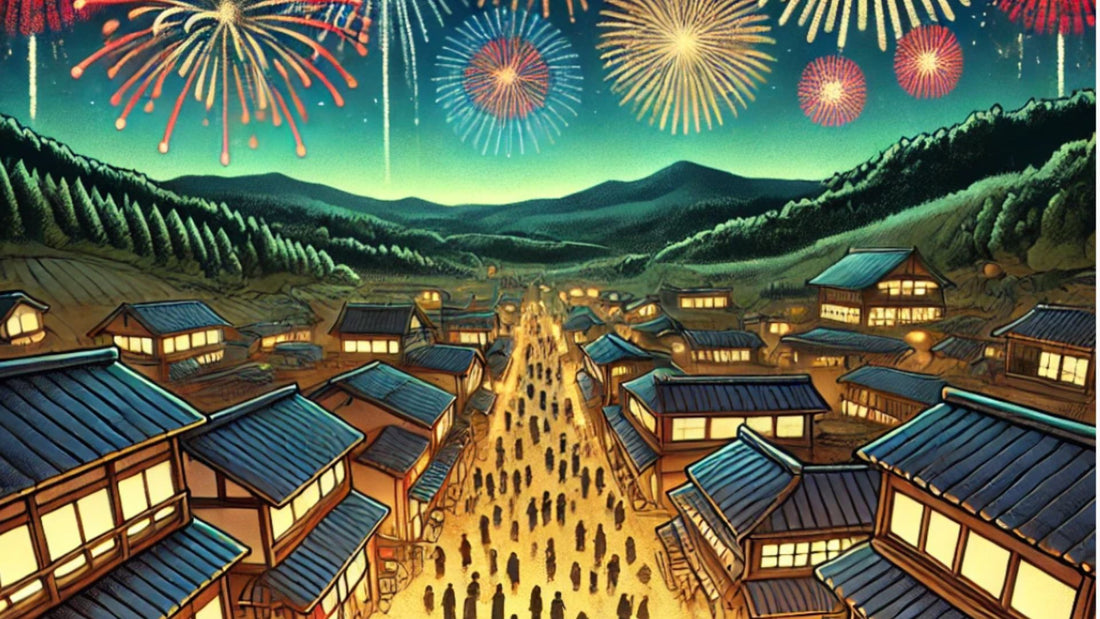Matsuri, the colorful and vibrant Japanese festivals, are an explosion of tradition, culture, and... oddities. From horse races in extravagant costumes to giant lantern processions and screaming contests, matsuri are a spectacle to remember. Get ready to immerse yourself in the most amazing celebrations and discover why these events are so much more than just a neighborhood party.
Don't know what a Matsuri is? No worries, let me explain…
If you think Japanese festivals are all about food stalls and fireworks, think again. A matsuri is more than just a neighborhood party. Deeply rooted in Japanese culture, these festivals are vibrant and colorful celebrations that blend ancient traditions, religious rituals, and a healthy dose of joie de vivre.
The word "matsuri" itself derives from the Japanese verb "matsuru," which means "to worship" or "to celebrate." These events usually have religious origins, often related to Shintoism or Buddhism. They are held to honor local deities, pray for bountiful harvests, or simply celebrate historical events. Each region, city, and even village in Japan has its own matsuri, often unique and tailored to their local traditions.
Matsuri are an explosion of color and sound. Think processions of mikoshi (portable shrines) carried by cheering crowds, parades of decorated floats (dashi) illuminated by lanterns, and traditional dances (bon odori) performed by participants in yukata (light summer kimono). Add to that taiko drum performances, sumo wrestling competitions, and stalls selling delicacies like takoyaki (octopus balls) and kakigori (shaved ice), and you have the perfect recipe for a successful matsuri.
But matsuri are not just feasts for the eyes and ears. They are also moments of communion and strengthening of community bonds. Families, friends and even strangers gather to participate in these events, sharing moments of joy and collective celebration.

In short, a matsuri is an immersive experience that immerses you in the beating heart of Japanese culture. Whether you are a curious visitor or an enthusiastic participant, each matsuri offers a unique adventure, full of surprises and discoveries.
The most famous matsuri
Gion Matsuri (Kyoto)
The Gion Matsuri is arguably one of Japan’s most famous and oldest festivals. It takes place every July in Kyoto and lasts for the entire month, culminating in two large float processions, called Yamaboko Junko, on July 17 and 24. The matsuri dates back to the 9th century, when it was held to appease the deities responsible for epidemics and natural disasters. Today, the Gion Matsuri is an explosion of traditional culture, with beautifully decorated floats, dancing, music, and colorful parades.

Gion Matsuri
Nebuta Matsuri (Aomori)
The Nebuta Matsuri, held every year from August 2 to 7 in the city of Aomori, is famous for its gigantic papier-mâché lanterns, called nebuta. These lanterns, often depicting historical warriors or mythological figures, are lit up and paraded through the streets to the sound of taiko drums, flutes, and the shouts of the participants. The festival attracts more than three million visitors each year, all of whom come to admire these moving works of art and take part in this vibrant celebration of light and color.
Kanda Matsuri (Tokyo)
The Kanda Matsuri is one of Tokyo's three major festivals, celebrated in May in odd-numbered years. Centered around the Kanda Myojin Shrine, the festival commemorates Tokugawa Ieyasu's victory at the Battle of Sekigahara in 1600, which led to the unification of Japan under the Tokugawa shogunate. The Kanda Matsuri features a grand procession of mikoshi (portable shrines), elaborately decorated floats, and participants in traditional costumes. The festivities last for a week, but the highlights are the processions that take place over the weekend.
Tenjin Matsuri (Osaka)
The Tenjin Matsuri, held on July 24 and 25 in Osaka, is one of Japan's three largest festivals. The matsuri honors Sugawara no Michizane, the god of learning and literature, and features a procession of illuminated boats on the Okawa River, kagura dance performances, and an impressive fireworks display. The festival begins with a land procession from Tenmangu Shrine to the river, where the celebrations continue on the water, providing a magical spectacle that attracts thousands of spectators.
Awa Odori (Tokushima)
Awa Odori, held from August 12 to 15 in Tokushima, is Japan's largest dance festival. This matsuri is known for its lively group dances, accompanied by traditional songs and music played on shamisen, flutes and drums. Participants, dressed in colorful yukata, parade through the streets performing distinctive dance movements. The origins of this festival date back more than 400 years, and today it attracts more than a million visitors each year, all eager to join in the dance and share in this unique festive experience.

The strangest matsuri
Japan is a country where tradition and eccentricity coexist harmoniously, and this is perfectly reflected in some matsuri that are truly out of the ordinary. Here's a look at Japan's strangest and most fascinating festivals, where local customs take on unexpected forms.
Hadaka Matsuri (Naked Men's Festival)
The Hadaka Matsuri, or Naked Men's Festival, is one of Japan's most famous and unusual matsuri. Held every February at Saidaiji Kannonin Temple in Okayama Prefecture, the festival sees thousands of men dressed only in fundoshi (a traditional loincloth) gather to compete in a test of sheer endurance. The highlight of the evening is the fight to catch sacred sticks, thrown by priests into a wild crowd. Those who manage to grab the sticks are guaranteed a year of good luck. Be warned, this festival is for men only, and you have to be prepared to brave the cold and the crowds!
Namahage Matsuri (Namahage Festival)
Namahage Matsuri, celebrated every year on December 31 in the Oga region of Akita Prefecture, is a festival where frightening demons called namahage make their appearance. Locals dress up as namahage, wearing terrifying masks and straw costumes, and go around the villages knocking on doors to drive away evil spirits and reprimand disobedient children. This festival, which combines folk beliefs and purification rituals, offers a unique and somewhat frightening spectacle, where the boundary between the world of the living and that of the spirits seems to fade.

Paantu Matsuri (Paantu Festival)
Paantu Matsuri, celebrated in October on Miyako Island in Okinawa Prefecture, is a bizarre festival where men dressed as paantu spirits, covered in mud and leaves, roam the streets to bless residents and ward off evil spirits. The paantu, with their macabre faces and muddy appearance, touch houses, objects and even people to bring purification and good fortune. Children, particularly frightened by these figures, often run and hide, adding a touch of comedy to this ancient tradition.
Kanamara Matsuri (Iron Penis Festival)
The Kanamara Matsuri, or Iron Penis Festival, is probably one of Japan's most bizarre festivals. Held every April at the Kanayama Shrine in Kawasaki, the matsuri honors Shinto deities of fertility and prosperity. Giant penises made of wood, metal, and candy are carried in processions, decorating the streets and food stalls. The festival, which has ancient origins in praying for protection from sexually transmitted diseases and for safe childbirth, has become a major tourist attraction, drawing visitors from around the world with its festive and slightly irreverent atmosphere.
Unusual rituals and practices
Here are some of the more unusual rituals you might encounter during these colorful festivals.
Ritual purifications
Purification is a central component of many matsuri, aimed at warding off evil spirits and bringing good fortune. At the Misogi Matsuri , for example, participants purify themselves by submerging themselves in icy waters or bathing under waterfalls, often in the dead of winter. This practice, while rudimentary, is believed to purify the body and mind, preparing participants to receive the blessings of the deities.
Offerings and prayers
Offerings and prayers also play a central role in many matsuri. Worshipers bring offerings of rice, sake, fruit, and other produce to Shinto shrines to thank the kami (deities) and ask for their protection. During the Sanja Matsuri in Tokyo, one of the largest Shinto festivals, hundreds of mikoshi (portable shrines) are carried in procession through the streets, each containing a local deity who receives prayers and offerings along the way.

Ritual dances
Ritual dances, or kagura , are another key element of many matsuri. These sacred dances, often performed by Shinto priests or professional dancers, tell mythological stories and celebrate the heroic deeds of deities. At Tokushima’s Awa Odori , thousands of amateur and professional dancers parade through the streets, performing synchronized dances accompanied by traditional songs and music. This joyful and energetic dance is an invitation to collective participation and the celebration of life.
Parades and processions
Parades and processions are a central feature of many matsuri, with participants, often in traditional costume, carrying portable shrines or decorated floats. During the Takayama Matsuri , for example, the streets of this small mountain town are filled with parades of floats richly decorated with mechanical dolls, called karakuri, performing theatrical performances. These processions are not only a stunning visual spectacle, but also a way to honor ancestors and celebrate local history.
Competitions and challenges
Some matsuri include competitions and physical challenges that test participants' strength, endurance, and courage. The Oniyo Matsuri in Kurume, Fukuoka, is known for its fire ritual, where participants must carry large flaming torches through the city. This spectacular ordeal is believed to purify the city and bring good fortune for the coming year.
Are you a foreigner and want to participate in the matsuri? Here are our recommendations
Prepare in advance
Before you go to a matsuri, do some research to find out the dates, locations, and main events of the festival. Many matsuri are very popular and draw large crowds, so it's a good idea to plan your visit in advance. Also, learn about the specific customs and practices of each matsuri to better understand what to expect.
Dress appropriately
If you really want to get into the spirit of the matsuri, why not wear a yukata (light summer kimono)? Many local participants wear this traditional garment, and it is often possible to rent or buy a yukata in stores or on site. Also, be sure to wear comfortable shoes, as you will likely spend a lot of time standing and walking.
Respect traditions and customs
Matsuri are deeply rooted events in Japanese culture and religion, so it is important to respect local traditions. For example, before entering a Shinto shrine, purify yourself by rinsing your hands and mouth in the designated fountain. Be respectful during processions and ceremonies, and follow the instructions of organizers and volunteers.
Participate in activities
Don't hesitate to participate in the various activities offered during the matsuri. Whether it's dancing in the parades, trying traditional games at the stalls, or tasting local specialties, your active participation will be greatly appreciated. Japanese people are often delighted to see foreigners interested in their traditions and will be happy to share with you.
Be careful about your behavior
Matsuri are times of joy and celebration, but it is important to be mindful of your behavior. Avoid speaking too loudly, pushing yourself into the crowd, or disrupting the ceremonies. Be courteous and respectful to other participants and the organizers.
Enjoy the moment
Finally, let yourself be carried away by the festive atmosphere and fully enjoy this unique experience. The matsuri are an opportunity to discover a vibrant and authentic side of Japan, so open your eyes, ears and heart, and let yourself be charmed by the magic of the festivities.




